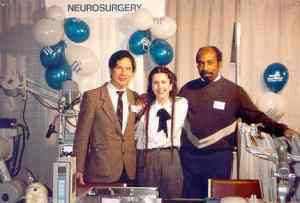The first male nurse to graduate from a BC hospital, James Bullen, finished his training at St. Paul’s School of Nursing in 1950. Coincidentally, he was the great-grandson of BC’s first medical doctor – Dr. JS Helmcken. In New Westminster, the first male nurse graduated from RCH in 1968.
That 1968 graduating class saw two massive changes in who could be a nurse. An article in the local New Westminster paper in late 1964 foreshadowed one of these changes, saying that a man had signed up as a student nurse. That’s all it said – no details of who it was (he preferred to remain anonymous), or whether the rules had changed – just that a male had signed up. Then in May of 1968, the following article reported that the first man had graduated from the RCH School of Nursing.
This article also refers to another huge change that would profoundly affect the career decisions of thousands of students – nurses could marry and still practice nursing. Technically, this was not a first. During the Second World War, there was such a shortage of trained nurses that, in order to fill the need, temporary licences were granted, married nurses were permitted to work and student nurses were allowed to marry, though only to servicemen. However, hospital rules often remained that a student could either be a nurse, or marry, but not both.
While it is unlikely that any of the student nurses named in this article are still nursing, some of these names may be familiar.
MAN GRADUATES AT HOSPITAL SCHOOL: NURSES LIKED ‘BIG BROTHER’

Rosalind Guppy, Roland Wood, Marna Dueck….graduates
NEW WESTMINSTER
“Three years ago, Roland Wood walked into a classroom at the Royal Columbian Hospital school of nursing and was asked by the teacher: “Yes sir, may I help you?” I’m Mr. Wood, and I’m a student,” he replied. Monday night, he ceased being a student and became a full-fledged nurse and the first male graduate of the school.
Wood, who was elected valedictorian of the class, was accompanied by 73 female nurses and one other male nurse, Reinhold Adolf Schmidt, of Chilliwack, at the graduation ceremony at Vincent Massey School auditorium. Schmidt started the course six months after Wood. Wood, 32, said he decided to become a registered nurse after working as a psychiatric nurse at Woodlands school for 10 years. “I decided to step up my qualifications, but the problem was finding a school which would take someone who was both male and married – and Royal Columbian did,” he said.
Wood said his fellow students were surprised but pleased with his entry into the class. “I’ve been sort of a big brother to the girls, and I’ve had a fair amount of wet shoulders during the course,” he said. In his valedictory address, Wood said the students had started out as strangers and had quickly become friends through their common study and work. “We came from many different backgrounds, in many shapes and sized, and for the first time in two sexes,” he said. He paid tribute to the girl graduates. “There are two times in your lives when you’ll look the most beautiful – once when you’re a bride, and once – right now,” he said.
Guest speaker, Eleanor S Graham, executive secretary of the Registered Nurses Association of BC, told the graduates they must make sure they still keep in touch with the patients. “The role of the nurse must change in the future, but the nurse must not be taken farther away from the patient,” she said.
The general proficiency award for the September 1968 graduating class was awarded to Mrs. Marna Dueck, 21, of New Westminster. Mrs. Dueck, who married eight months ago after regulations on marriage were relaxed, said she had always wanted to nurse. “It sort of runs in the family – four of my cousins are nurses too,” she said. Mrs. Dueck said she hopes to enter public health nursing and perhaps work overseas. Her husband, Peter, is a social worker.
Winner of the general proficiency medal for the February, 1968 class was Rosalind Guppy, 23, of New Westminster. The Dr. J Margullius Medical Nursing Award was presented to Annie Millar of Coquitlam, and the Dr. George T. Wilson Surgical Nursing Award to Carolyn M. Davies, of Vernon. The obstetric nursing award for the February class went to Judith C French, of Burnaby, and the paediatric nursing award to Sandra Yurick of Vernon. The September class obstetric award was presented to Fracya C Miller of Vancouver. Barbara Clippingdale, of North Burnaby, won the medical nursing award, and Magdalena Ruesch, of New Westminster, the surgical nursing award.”
Vancouver Sun, May 7, 1968


























